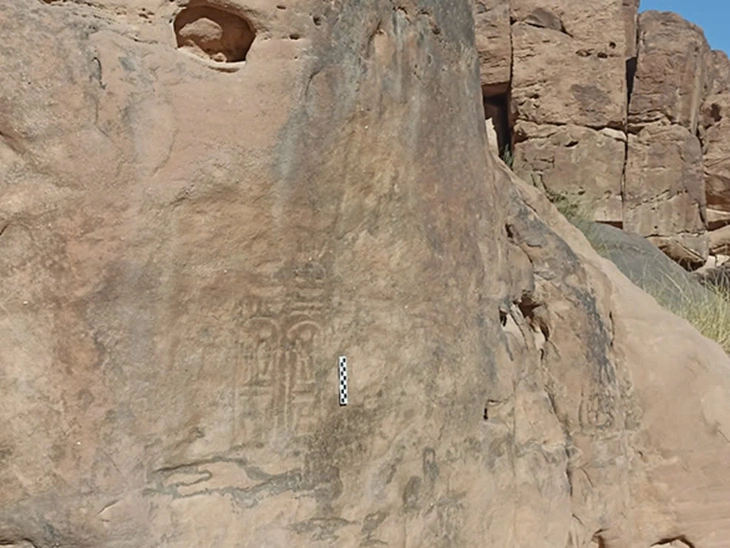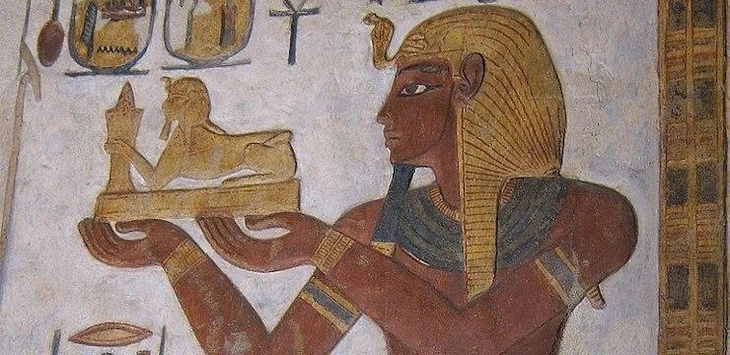Pharaoh hieroglyphs engraved with the royal seal belonging to King Ramses III of ancient Egypt in Jordan - Photo: Jordan Ministry of Tourism and Antiquities
On April 19, Jordan's Minister of Tourism and Antiquities, Lina Annab, announced that archaeologists in the country discovered an ancient Egyptian hieroglyphic inscription, which included the royal seal of Pharaoh Ramses III (reigned from 1184 - 1153 BC).
This is the first time such a relic has been discovered on Jordanian territory, opening a new chapter in the study of the relationship between the Nile civilization and the wider Arabian Peninsula region.
Ms. Annab could not hide her excitement when calling Jordan an "open library" with a rich epigraphic heritage, while emphasizing that the newly discovered hieroglyphic inscription provides an important new perspective on the written heritage of this Middle Eastern country.
Important step forward in archaeological research
Accompanying Ms. Annab was the famous Egyptian archaeologist - Dr. Zahi Hawass. He emphasized: "This is the first inscription of its kind found in Jordan and is a rare, concrete evidence of the presence of ancient Egyptian civilization in the region."
He said the two inscriptions found included the birth name and throne name of Pharaoh Ramses III, thereby confirming that this king once ruled both Upper and Lower Egypt.
Dr. Hawass assessed this as a discovery of great significance, opening up the possibility of a deeper understanding of the interaction between ancient Egypt with the southern Levant region and the Arabian Peninsula more than 3,000 years ago.
He called for organized excavations in the area to find more artifacts that would help shed light on the historical relationship between Jordan and Egypt.
Pharaoh Ramses III is considered the last great king of the New Kingdom of Egypt - Photo: Arkeo News
A joint effort between Jordan and the Saudi Arabian Heritage Commission is aiming to trace Ramses III's military campaigns in the region, marking a major step forward in archaeological research.
Pharaoh Ramses III (reigned 1186 - 1155 BC) is considered the last great king of the New Kingdom of Egypt. He is famous for his exploits against the “Sea People” - an alliance of pirate groups that once threatened the stability of Egypt.
Ramses III was also the builder of many monumental structures, including the Medinet Habu temple - a place of worship and a testament to his power.
Efforts to preserve the common cultural heritage of ethnic groups
The international archaeological community expressed excitement at the discovery. Dr. Aktham Owaidi, acting director general of Jordan's Department of Antiquities, praised the international cooperation and the importance of cultural and scientific exchange.
He affirmed that Jordan continues to be a beacon of heritage, with great influence both in the region and the world.
Professor Ahmed Lash and Dr. Ali Manaseer - two Jordanian archaeologists are also actively participating in recording and analyzing the inscription.
This is considered an important part of the region's ancient writing treasure, reflecting the efforts to preserve the common cultural heritage of the ethnic groups.
Minister Annab expressed gratitude for Dr. Hawass's contributions to the field of archaeology and heritage conservation, and stressed the role of international cooperation in shedding light on ancient civilizations.
She said an official announcement of the discovery would be made after the research and analysis process was completed, to ensure a comprehensive view of its historical significance.
This discovery not only enriches Jordan's archaeological story, but also cements the kingdom's position as a pivotal figure in the region's historical landscape, reflecting the deep connections between the ancient civilizations that once existed and interacted here.
Read moreBack to Topic Page
Back to topic
REVELATION
Source: https://tuoitre.vn/tim-thay-dau-an-pharaoh-ai-cap-co-dai-o-jordan-20250420110954995.htm



































































































Comment (0)